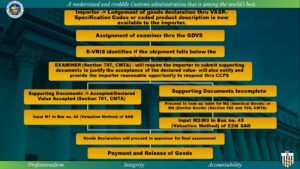

Customs appraisers should not immediately upgrade valuation of shipments when there is a “valuation hit,” or when the declared value is below the minimum range, according to a Bureau of Customs (BOC) official.
Instead, the appraiser must first verify or check documents presented by the importer. If there is reasonable doubt or supporting documents are lacking, the appraiser should then require the importer to submit additional documents supporting the declared value of the shipment, according to Import Assessment Service’s Romeo Leneses, Jr. in a recent BOC webinar.
If the supporting documents are accepted and the importer proves the declared value is the price that was actually paid or is payable, the appraiser should then continue on with the process using Method 1 (transaction value) of the Customs valuation system, Leneses said.
But if the documents presented for review are incomplete, not authenticated, or found to be illegitimate, and the importer is unable to establish that the declared value is the price actually paid or is payable, the appraiser should then proceed with the subsequent methods of valuation.
Leneses said implementing the subsequent methods of valuation, particularly Method 2 (transaction value of identical goods) and Method 3 (transaction value of similar goods) is now allowed through BOC’s enhanced Value Reference Information System (e-VRIS), which was formally launched last August.
READ: BOC rolls out new database for reference values
The e-VRIS serves as BOC’s new database of reference values and is integrated into the agency’s Electronic-to-Mobile (e2m) System. The e-VRIS has replaced the National Value Verification System (NVVS), which had received complaints and concerns from stakeholders from the moment it was implemented by BOC in 2019.
The e-VRIS provides for a look-up table of identical and similar entries from where appraisers can select the values of identical or similar entries when the shipment for valuation is rejected under Method 1. Under e-VRIS, assessment personnel are required to identify the valuation method used.
The system also now allows the automated flagging of potentially undervalued goods, or goods whose declared values fall below the minimum range. Leneses noted that this is the risk management functionality of the e-VRIS.
Moreover, the system now makes available to importers and declarants a list of specification codes of products during the lodgment phase.
Under Customs Memorandum Order (CMO) 16-2020, which established the e-VRIS, declarants are mandated to fill in Box No. 33 (Specification Code) of the goods declaration upon lodgment in the e2m system. Declarants will be provided with a coded product description list in the form of a drop-down menu, and they must select the appropriate specification code of the goods to be lodged.
For goods with no specification code, the declarant should use “others” and manually input the specific description of the goods in Box No. 31(Packages and Description of Goods). The mandatory filling in of Box No. 41 (Supplemental Units) is also included under the CMO.
BOC earlier said e-VRIS would help Customs “establish a reliable and comprehensive database of information on the value and classification of imports for reference purposes in support of the implementation of the World Trade Organization’s (WTO) Valuation System.”
“These values are not to be considered substitute values but only reference values to assist assessment personnel in the valuation of goods. Further, assessment personnel are mandated to value imported goods pursuant to the provisions of Section 700-707 (Sequential Application of Valuation Method) of the Customs Modernization and Tariff Act (CMTA),” BOC added.
CMO 16-2020 covers the lodgment of goods declaration under consumption entry. – Roumina Pablo




